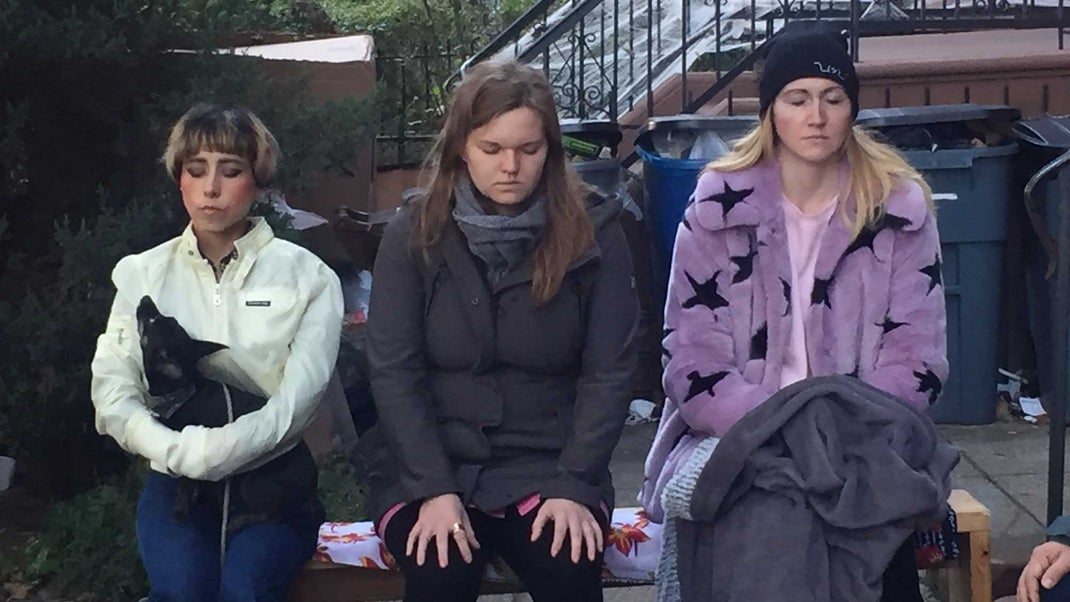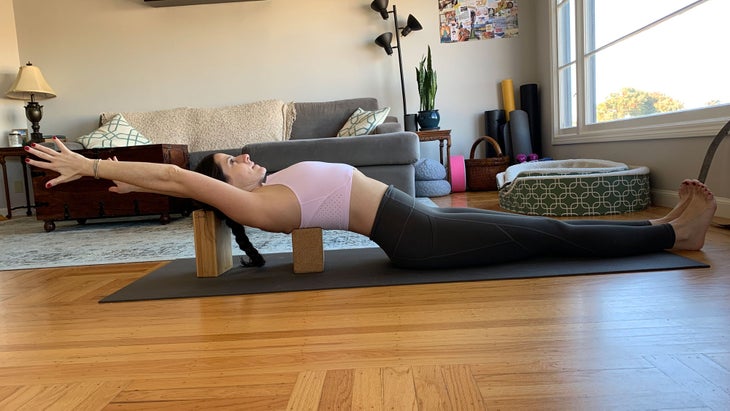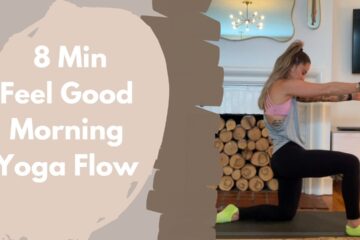The sun was rising as I headed up Washington Avenue in Brooklyn, New York, to Danielle Fazzolari’s Brooklyn Brownstone recently. I was set to participate in the last of her weekly, 7:30 a.m. Stoop Meditation sessions, which she began organizing in 2016 and now run from April through October.
A simple, hand-written sign hung from the front iron gate of her building that read, “Stoop Meditation: All Are Welcome.” As a handful of class regulars strolled in, they chatted as they sat on the stoop’s steps and nearby benches. Folded blankets were scattered, too.
Seventeen people ultimately made up our group, and Fazzolari sat on a vintage suitcase to open class. She spoke about her gratitude for these gatherings, which would be ending for the winter season, urging everyone to continue to love themselves and one another until sessions resumed next spring.
Next, Fazzolari led us through a 20-minute guided meditation, encouraged us to turn our energy inward and to connect with our breath. Easier said than done, I thought to myself, as every possible street noise imaginable sounded off in midst of our mindfulness—from school buses and ambulances to high-heeled pedestrians and kids scurrying on the sidewalks. Fazzolari embraced it all, inviting us to do the same: “Listen to every sound, she said, and find the meaning behind it.”
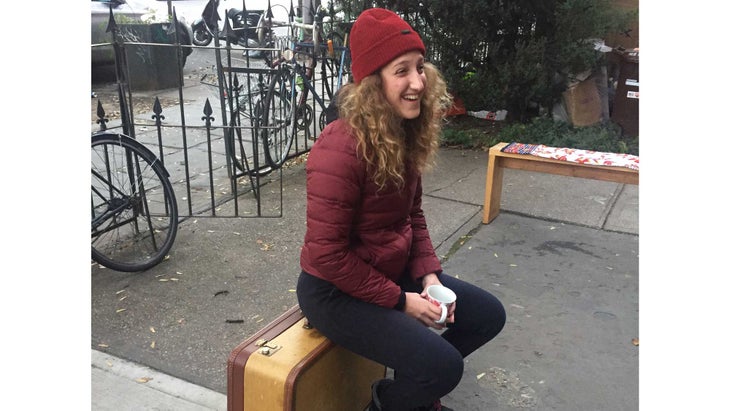
Pause and effect
For Fazzolari, the ability to tune out the non-stop commotion in order to pause, turn inward, and just was a skill she’d honed after leaving her decade-long career in global sales for Saks Fifth Avenue. She’d wanted to give back, she says, so began volunteering.
“I quit my job with no money, wanting instead to spread love and peace. I knew I’d figure it out,” she says. After traveling to India, where she says everyone spoke of meditation as “the secret” to her goal, “I tried basic breathing meditation at home and an app called, Oh My God I Can Meditate,” she says. “It was the first time I’d gone inside. I stopped asking everyone else for advice and answers and began to get to know my own heart. Feeling my body and breath in silence—I had such relief sitting still and paying attention.”
To further her meditation practice, Fazzolari worked the front desk at MNDFL, a popular New York City-based meditation studio. Inspired by the practice, she went through their teacher training, completed a Mindful Schools Online Training, and began teaching meditation to children at New York City schools. Then, at age 30, she thought: What if all kids grew up loving themselves so much and looking at others, knowing they are enough as well?
When Donald Trump won the Presidential election, the seed for Fazzolari’s Stoop sessions was planted.
“I woke up the next morning so confused and a bit worried,” she says. “Whether you voted for him or not, I felt we shouldn’t be alone right now. I thought, Let’s explore our feelings together,” she says.
To help herself and her community, Fazzolari contacted her neighborhood block association for permission to host a free Stoop Meditation session. With their approval, she emailed 70 members and held the first event a couple of days after the election.

“Just seven people showed up,” she says. “It was freezing. I guided us through a meditation to connect us to our bodies and breath, and to have compassion. There were no rules; just an encouragement to feel whatever it is we were feeling, to turn to each other, and be there for one another.”
What was meant to be a one-time gathering was so well received, Fazzolari was encouraged to continue regularly. She credits her choice to congregate on her stoop instead of an indoor space or yoga studio in large part for her success.
“The stoop is not intimidating,” says Fazzolari. “Personally, I get nervous coming into a new studio—it stirs something inside of me. This is why I stand outside early on the stoop before class. I try to break down those barriers.” The stoop is also great because it’s accessible to everyone in the community, she says.
Now, Fazzolari has plans to develop her platform and curriculum for meditation teachers to follow and says that continuing classes outside is key.
“People passing by see what’s happening and can choose to come and be a part of a community or not,” she says. “Meditation should be accessible to everyone—whether you live in a million-dollar apartment or you’re homeless. Anyone can join.”
For Fazzolari, the impact of her work on others is deeply rewarding.
“The political situation in our world is influencing the lives of so many people. Sometimes we feel powerless. Sometimes we need compassion. One way we can help to make a change is to begin to see the interconnectedness of this life, and to appreciate ourselves and our neighbors more.
“The simple joy in getting to know the people we share this corner of the universe with—that’s the real impact. The strongest power of all is human connection.”
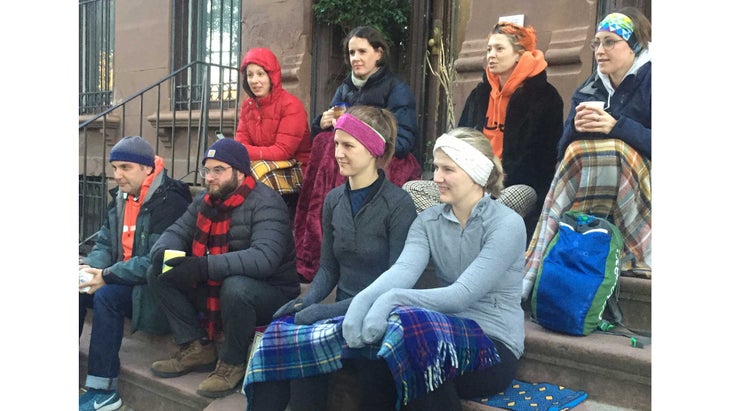
3 Tips for Leading a Meditation Group
Interested in starting something like Fazzolari’s Stoop Meditation sessions? Here’s how:
Follow a format. Decide if you want to bring in a meditation teacher to guide the sessions, or simply sit in silence together. Then discuss your practice, share a reading, or simply chat with each other.
Spread the word. Reach out to your neighbors and friends in simple ways. Post flyers in your local coffee shop, library branch, or laundromat. Write about what you’re doing on social media, and on online community sites like NextDoor.com.
Start small. Remember, a group of two is a group—so start small and let your gatherings grow organically. If you want to join an existing group, you can research local sanghas online. Check out Thich Nhat Hanh’s sangha directory to start.
About the Author
Erika Prafder is a veteran writer for The New York Post and the author of a book on entrepreneurship. A longtime yoga enthusiast and Hatha yoga teacher, she edits kidsyogadaily.com, a news source for young yogis.
Conclusion:
One Yogi Started a Meditation Group—on Her Front Stoop. One way we can help to make a change is to begin to see the interconnectedness of this life, and to appreciate ourselves and our neighbors more.
